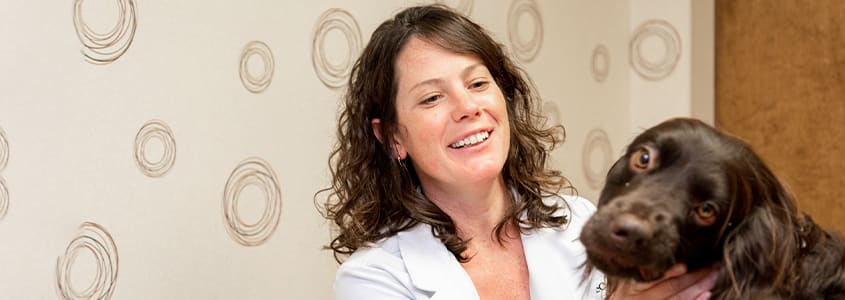Ringworm in dogs is a common condition that can be challenging to get rid of. Here, you will learn the signs of ringworm in dogs, how it's diagnosed, treatment and how to prevent the spread to other pets.
What is ringworm in dogs?
Ringworm is a common fungal infection often seen in dogs and other animals. Interestingly, when this fungal infection occurs on our own feet we refer to it as Athlete's Foot. Unfortunately for pet parents, preventing the spread of this resilient fungus can be a real challenge.
By familiarizing yourself with the signs of ringworm and taking prompt action, your veterinarian will be able to address the infection swifty helping you in your battle to prevent the spread of this condition to other pets.
What does ringworm look like on a dog?
Ringworm most commonly appears on dogs as patches of hair loss with a crusty coating, although in some rare cases, dogs with ringworm can actually be asymptomatic and show no signs at all. Dogs who are very young, elderly, or have long hair are more likely to be impacted.
If your canine companion has contracted ringworm the condition could present in a number of ways, from grey, scaly patches, to bald spots, or bright red lesions.
Schedule a veterinary appointment for your pup right away if you notice any of the following symptoms:
- Dry, brittle hair
- Inflamed, red skin rash
- Circular or patchy areas of hair loss
- Scales that look like dandruff
- Scabs or lesions on the skin
- Darkened skin
- Reddened skin
- Inflamed folds of the skin around the claws or nails
- Itchiness
How is dog ringworm diagnosed?
If you are concerned that your dog may have ringworm then you will need to schedule a veterinary visit right away! The only way to resolve your pup's skin infection is with treatment.
Your veterinarian may use a variety of methods to diagnose ringworm in dogs. One of the first steps is a thorough physical examination of the affected areas to look for characteristic signs such as circular patches of hair loss, redness, crusting, and scaling.
To confirm the diagnosis, they may perform a Wood's lamp examination, which involves shining a special ultraviolet light on the suspected areas. In some cases, the affected hairs may fluoresce, indicating the presence of ringworm.
Your vet may also choose to perform a fungal culture by collecting hair and skin samples to grow and identify the specific fungus responsible for your dog's skin infection. This allows for a definitive diagnosis and helps determine the most effective treatment plan for your dog's infection.
What is the treatment for dog ringworm?
The treatment of ringworm in dogs involves a multi-faceted approach that aims to eliminate the fungal infection and promote healing.
Veterinarians commonly prescribe antifungal medications, either in oral or topical forms, to combat the infection. Oral medications are often used for severe or widespread cases, while topical treatments, such as antifungal shampoos or creams, are suitable for localized infections.
Additionally, regular bathing with medicated shampoos can help remove fungal spores from your dog's coat.
With proper care and treatment, most dogs can recover from ringworm and regain their healthy skin and coat.
Is it possible to stop the spread of ringworm in dogs?
Ringworm can endure anywhere from 6 weeks to 18 months, and while it is not as concerning as other potential infections it should still be managed seriously. In order for ringworm to spread, there must be direct contact with an infected animal or surface contaminated with the fungal spores. All surfaces must be cleaned properly otherwise ringworm will continue to survive, this includes the fibers of the carpet, bedding and curtains.
Do I need to quarantine my dog if they are being treated for ringworm?
Unfortunately, your four-legged friend may be a ringworm carrier even if they are asymptomatic and show no obvious signs of the condition. Ringworm spores are very resilient and can survive in the environment for a very long time, so it may be helpful to confine your affected dog to a single room while their treatment is ongoing, even if their obvious symptoms clear up.
If you heal your dog but do not eliminate the virus from your home, your dog can very easily become reinfected. Ongoing thorough cleaning of bedding, grooming tools, and living areas will be essential while treating your pup. Keeping your pet contained to only particular areas within your home will help you to reduce the amount of work you will need to do to fight the spread of ringworm.
How long should I quarantine a dog with ringworm?
Ideally, you should try and keep your dog quarantined for about six weeks while you battle ringworm. This can certainly sound daunting, nonetheless, it will likely make treatment easier and less expensive in the long run compared to having a constant battle against recurring cases of ringworm.
Throughout the treatment process, close monitoring of your dog's skin condition by your veterinarian will be necessary to ensure the infection is effectively controlled and to make any necessary adjustments to the treatment plan.
Note: The advice provided in this post is intended for informational purposes and does not constitute medical advice regarding pets. Please make an appointment with your vet to accurately diagnose your pet's condition.

